This story from the Australian Aviation archives is from December 2009, when Paul Sadler wrote about the Airservices Australia flight inspection service.

The blue and white King Air making a high speed “clean” approach and then performing a go-around from 50ft AGL is a common site at Australian airports. And for good reason – it’s all in the name of safety.
Airservices Australia, the provider of air traffic management services throughout Australia, is responsible for regularly conducting flight calibration inspections on approximately 500 navigational aids (navaids) using two specially equipped Beechcraft King Airs. Airservices Australia’s Flight Inspection Service (FIS) continually calibrates Australian, and some overseas, navaids on a three year rotational basis to ensure these vital pieces of navigation and safety equipment are operating within the required high tolerances.
Since September 1997 Airservices Australia has contracted the operation and maintenance of the flight inspection service assets to Brisbane based AeroPearl, a joint venture between parent company, Darwin headquartered Pearl Aviation Australia, and the German manufacturer of sophisticated flight inspection systems Aerodata AG, to maintain and service instrument landing systems (ILS), VHF omni-directional range (VOR), distance measuring equipment (DME), tactical air navigation (TACAN) and non-directional beacons (NDB) navaids and surveillance radars at major airports and en route locations. FIS also inspects airport approach lighting including visual approach slope indicator (VASI) and the precision approach path indicator (PAPI) aids and calibrates the ADF’s military airfield navaids and radars and TACANs installed on Navy ships.
“Every ILS, the most important navaid of them all, has to be inspected every six months,” explained Airservices Australia’s contract manager flight inspection services, Graham Jackson. “Other navaids like conventional VORs are inspected every 18 months, Doppler VORs every 36 months and NDBs every 36 months.”
Airservices Australia predecessor the Civil Aviation Authority first operated a Commander 695A for FIS flights before upgrading to two Fokker F28s.
But miniaturisation and developments in technology meant large airliner sized aircraft like the F28 were no longer required to carry the cumbersome analogue calibration equipment and personnel to operate the system. So in 1997 Airservices Australia sold off its Fokkers and introduced an Israel Aircraft Industries 1125 Astra SP, VH‑FIS, into service fitted with new, smaller and lightweight digital flight calibration technology developed by Aerodata.
“The Astra jet offered better speed between destinations, a higher altitude for calibrating radars and better speed around an airport,” said Jackson. “The Astra was one of the best aircraft you will ever find for flight inspection work, but it was very expensive to maintain and operate.”
Since 1997 AeroPearl has been operating King Air 350 VH-FIX, owned by Airservices Australia, and in 2001 its own King Air 200, VH-FII, for the flight inspection work.
“When you are conducting a missed approach for an inspection the controllers appreciate you clearing the airspace as soon as possible to assist with the approach flow. With a turboprop they are slower in comparison to a jet but they don’t cost as much to operate.”
Both the King Airs are fitted with an Aerodata AD-FIS-8 advanced flight inspection system coupled to the aircraft’s autopilot. The system provides data processing and detailed report generation in real time during the calibration of a navaid.
Taking up almost half of the aircraft’s cabin, the flight inspection system features a console down the left side of the fuselage. The flight inspector is presented with two LCD screens, displaying flight, positional and inspection telemetry. The system is controlled by a keyboard and trackball and is linked to a bubblejet printer for the instant printing of results.

UPDATE
At July’s Waypoint Conference Airservices Australia detailed its $900 million capital expenditure program to upgrade its air traffic assets, including an aircraft replacement program.
But instead, “We have decided to pull the FIS aircraft replacement out of the capital replacement program and we will soon go to market for a full turn-key solution,” said Jackson. “The winning tender will supply the aircraft, equipment and crew and we will just buy in the service.”
AeroPearl’s contract was to expire in 2008, but Airservices Australia chose to extend the life of the contract and to update the equipment onboard VH-FIX to ensure service continuity through until the commencement of a new contract.
In August VH-FIX was taken off line for the installation of an upgraded AD‑FIS-8-R flight inspection system, which AeroPearl and Aerodata carried out at Brisbane Airport. “We have upgraded the equipment on our aircraft which will see us through until the introduction of the new turn-key contract.”
Having recently completed several test flights VH-FIX was expected to be recommissioned into service by the end of November.
AeroPearl is certainly a contender for the new contract and will likely be competing with a small number of companies in the Asia Pacific region, including two in New Zealand and some in Australia with close ties to European companies that conduct flight inspections on a commercial basis. A decision on the new contract provider is expected to be announced in late 2010.
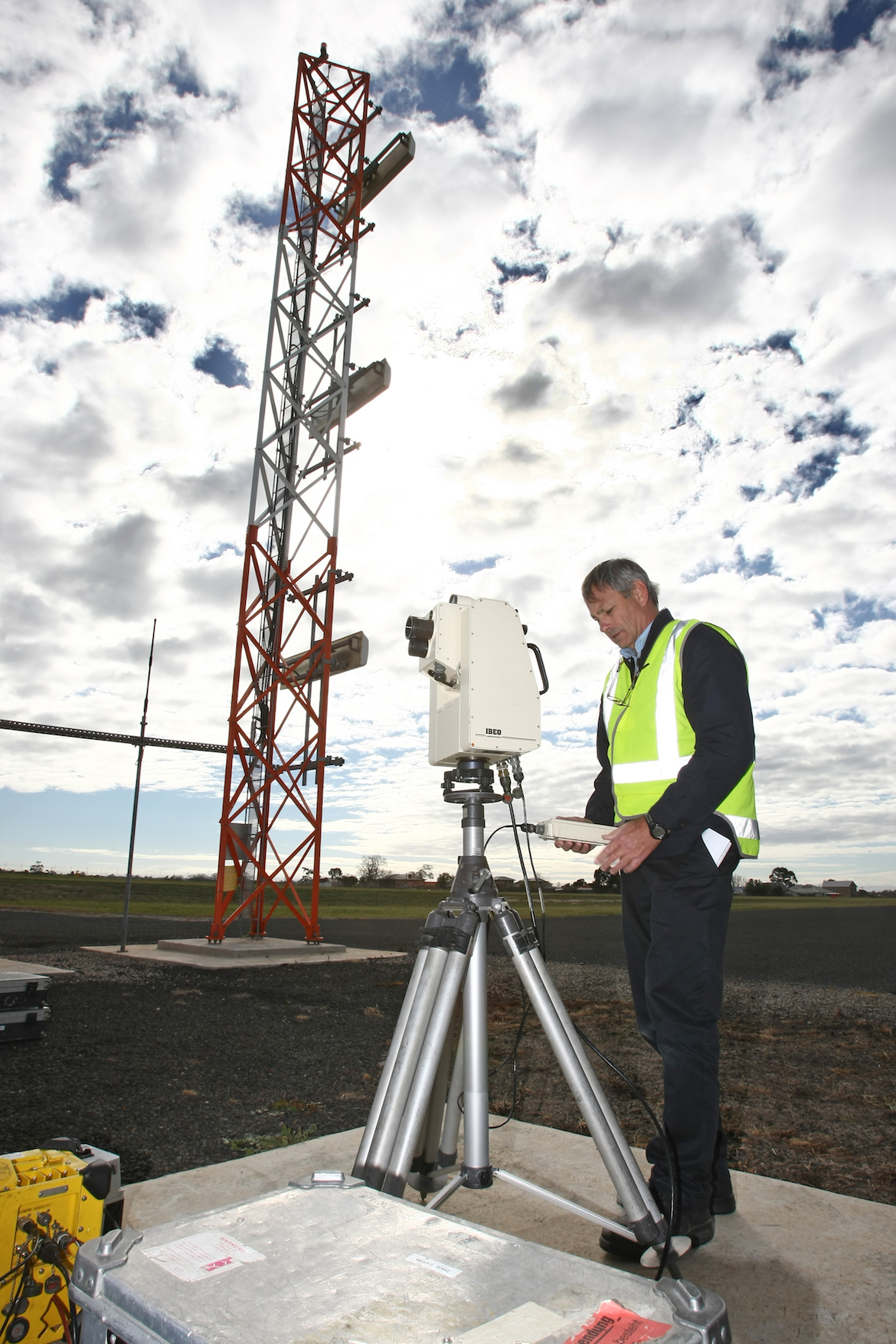
HOW IT WORKS
The majority of FIS’s flight inspections are to calibrate ILS glideslopes and localisers – the most critical of all the navaids to calibrate.
Before the FIS aircraft becomes airborne for an ILS inspection, ground equipment is set up adjacent to the glideslope tower facing upwind of the approach.
Used is an IBEO Aerotrack 1B laser tracker, a three-dimensional distance measuring system, operating with a high accuracy over an extreme range.
The laser tracker is erected on a tripod directly over a surveyed mark, set in concrete near the runway, and calibrated to confirm its own position.
A differential global positioning system (DGPS) is also used for ILS inspections. DGPS values obtained during a calibration are used as a secondary means to confirm the aircraft’s position during an approach.
Historical data about the ILS approach, obtained during commissioning of the navaid and from previous inspections, is loaded into the flight inspection computer onboard the aircraft for cross referencing the approach.
Behind the nosewheel a reflector box is attached to a surveyed position on the aircraft. Comprising nine individual reflector prisms, the box has an unobstructed view of the approach when the landing gear is retracted.
Airborne and the FIS aircraft, crewed by a pilot-in-command, support pilot and flight inspector, flies the ILS approach following radio beams being emitted from the glideslope transmitter, providing pilots with an optimum descent angle of three and a half degrees, and from the localiser transmitter, which provides lateral positioning in relation to the runway’s centreline.
Running in on a 10nm approach the tracker locates the reflector box on the aircraft by scanning the target area. A laser beam from the tracker is directed at the aircraft, reflecting off the reflector box back to a receiver on the ground. Via telemety, details of the aircraft’s distance, elevation and azimuth are transmitted to the computer onboard the aircraft and compared against the historical data to ascertain if in fact the aircraft is where it should be and confirming the navaid is operating within the defined limits.
FIS measures to within three decimal places of one degree, exceeding ICAO’s requirements for the required level of accuracy.
While working for the same team, the Airservices Australia FIS aircraft are handled or sequenced by ATC just like any other aircraft. “To ATC we’re probably like a pebble rolling around in the bottom of a shoe – always getting in the way and annoying everyone,” said AeroPearl pilot Richard Blatchford.
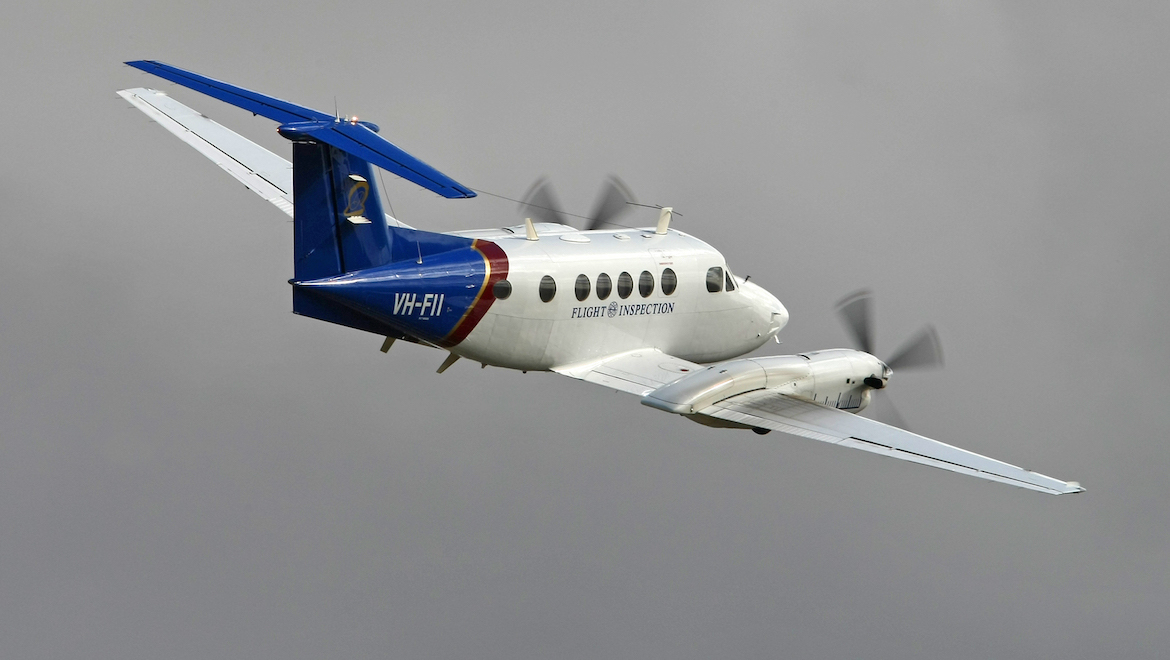
AROUND AND AROUND
On each run various limits and values of the approach are checked including outer and middle marker fly-through distances and their audible tones, glideslope and localiser angles.
Up to 20 approaches can be made during each ILS calibration. On certain ILS approaches FIS aircraft perform a go-around at 50ft AGL to set up for the next run.
“The regulations say you can’t go below 500ft unless you are doing a takeoff or landing so we have to have a low level endorsement to meet the regulation requirements,” explained Blatchford.
With the pilot-in-command’s head down and attention focused on the ILS ‘cross hairs’ a great deal of emphasis is put on the support pilot. “The support pilot works harder than the command pilot,” noted Blatchford. “The support pilot is coordinating with the flight inspector while at the same time talking with ATC, getting clearances and instructions from them.”
Each King Air averages between 600-800 hours of flight time a year with AeroPearl pilots – alternating roles to share the workload – clocking up between 450-500 hours per year.
During a recent calibration of the ILS at Avalon Airport the FIS pilots undertook 23 approaches, all the while battling with a 30kt crosswind.
“Because of the nature of our work we try and not to do more than five hours of calibration in a day,” said Blatchford. “The required accuracy has to be spot on for the equipment in the back to do its job properly.”
For a very experienced pilot it takes approximately six months of flight inspection training before they attain the experience required to perform FIS work.
“It’s a very intense six months too,” explained Blatchford. “The extra skills you have to pick up for this job are enormous, because almost everything is not standard. No-one else around us knows what’s going on, although ATC have been briefed, there’s always some little hitch somewhere that you have to keep looking out for.”
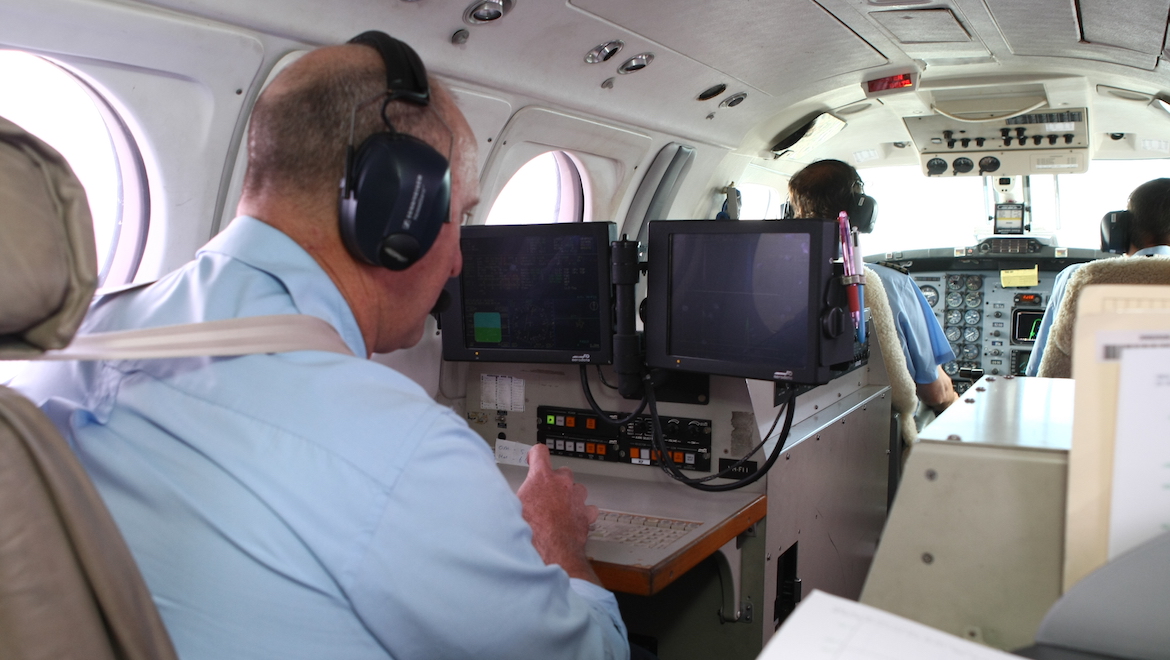
FLIGHT INSPECTOR
Conducting a “run” is just as demanding for the flight inspector as it is for the pilots up front. Monitoring two LCD screens while tapping on a keyboard and driving a trackball is not as easy as it sounds, especially during turbulent conditions at low level.
“We don’t tend to make adjustments to the ILS ‘on the fly’ as that can alter other values, but we certainly let the ground calibration crew know if it is out of specified tolerances,” said flight inspector Tony Hine. “They will then make a decision if they want to make a correction there and then or not. We have the data recorded which allows a replay function should we need to go back and examine any anomalies.”
To be a flight inspector you need to understand both the equipment on the aircraft and on the ground. “You have got to have a good radio navigation background to be a flight inspector,” said Jackson. “Because if you have a problem during a flight you have to ascertain ‘is the problem in the aircraft or is it on the ground’?
FIS requires flight inspectors to have a CASA certification equivalent to a diploma in electronics with a background in radio navigation. “But you can’t just know about the navaids, you’ve got to know about the new technology as well.”

CHALLENGES
The flight inspection environment is a world of technical data and fast moving aircraft, usually at low levels. With the restriction of only being able to undertake calibrations during daylight VMC hours, challenges are aplenty for FIS crews in the air and on the ground.
“We generally calibrate the Navy’s radars and TACANs before they deploy overseas and from our perspective it’s the most challenging navaid of the lot to calibrate because basically it’s a moving runway,” explained FIS pilot David Thomas. “If the ship changes course or changes speed we have to recalculate where we’re going to be in relation to airspace.”
Aside from “moving runways”, Sydney Airport with its six ILS equipped runways poses as the most challenging location for FIS to calibrate.
FIS needs up to 20 approaches for each ILS, calibrated twice a year, with each inspection approach at a major airport taking a “slot” otherwise for an airline. “That is a lot of slots that are taken away from the industry,” said Jackson. “But industry has to understand that it has just got to be done. The window to undertake calibration at Sydney is getting smaller and smaller all the time. We can only do it on weekends when movements are at the lowest.”
At Sydney, with a good run at it, each ILS can be completed in two hours. But it could take FIS a month to get those two hours.
“We are pretty good with our approaches and we use reasonably reliable equipment so we’re getting the job done as best we can. When we purchased our current calibration equipment the manufacturer, Aerodata, said by using the new digital system we would gain a 40 per cent increase in calibration efficiency. I believe we have gained a lot more than 40 per cent.”
Jackson related, “A few months ago we did an inspection at an airport, on a Friday in under two hours, and we thought we did a really good job to get it done that quickly. But next minute we got airlines complaining that we were delaying their schedules. I can appreciate their frustrations but it’s important that we get the job done. This is where we were hoping that technology would have caught up by now and we would have something in the middle of the airport where we could do a circuit around it and calibrate every ILS at the same time.”
GBAS
In time the pending introduction of GBAS (ground-based augmentation system) will change the nature of FIS’s work, as this technology should eventually replace ILS.
Airservices Australiaplans to instal Honeywell Smartpath SLS-4000 GBAS units at major airports around Australia after the system was awarded FAA certification in late September. GBAS is recognised by ICAO as a future replacement for ILS and is a critical component of Australia’s planned next-generation air traffic management infrastructure.
A single GBAS installation at an airport can guide up to 48 highly precise approaches simultaneously, initially to Cat I but eventually to Cat III standards.
Sydney Airport is the first Australian airport to feature the system, which is due to become operational by the end of the year. Further assessments will be undertaken to consider expanding the GBAS service to other airports in Australia.
GBAS will mean lower capital investment and ongoing maintenance costs including fewer flight inspections, and will allow for continued operations during flight inspections or airport works.
Airservices Australia is working with CASA to achieve the GBAS CAT I service approval by 2010.
“Before ILS is replaced ICAO says it requires a GPS approach system, like GBAS, and conventional instrument landing systems to be run in parallel to validate the satellite based system’s accuracy and reliability,” said Jackson.
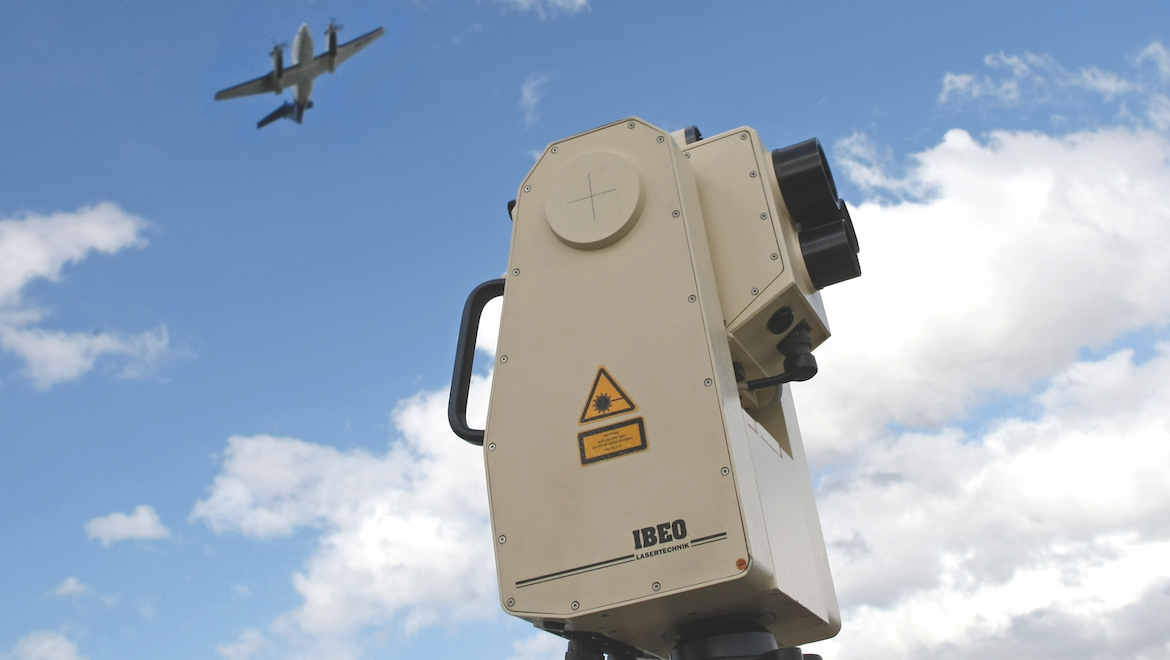
INCIDENT RESPONSE
Interestingly, the FIS crews are on constant standby in the event of a major incident occurring at a navaid equipped airport.
“If there is a suspicion that the accident may have involved a navaid we would be called in to assess the navaid, no matter where we are in the country at the time,” said Blatchford. “Before any aircraft can land on the incident runway we will conduct a calibration check. Fortunately this hasn’t happened but it is one of our functions. If there is some question about the navigation aid in relation to an accident we will investigate it.”
FIS will also respond to reports of anomalies observed by pilots.
“If we receive a report of something unusual happening during an approach we will set up and repeat exactly what the crew did and investigate.”
OVERSEAS FIS
At the beginning of its flight inspection contract with Airservices spare excess capacity was soon found.
“When we got really efficient with what we were doing, if we didn’t have one aircraft sitting there doing nothing we had two – we just didn’t have enough extra work,” said Jackson.
So AeroPearl was able to pick up several overseas inspection contracts and in turn was able to reduce its costs to Airservices Australia by using its assets and paying per hour lease payments. “This came off the bottom line for us and it was passed straight on to industry.”
AeroPearl conducts flight inspections at airports and en route navaids in Singapore, Cambodia and Vietnam, and has gone as far afield as India to Leh, one of the highest airstrips in the world at 10,000ft.
“The first time we went to India we had an Indian Air Force navigator on board as there was a set route in and out of the airfield because of a war zone,” explained Blatchford. “We were calibrating a VOR up at around 27,000ft which put us in the middle of the Himalayas.”
AeroPearl commissioned the navaids at the refurbished and modernised New Delhi Airport in 2006. The commissioning of a new navaid requires double the usual time to ensure the equipment is within limits and to obtain accurate data to be used as a benchmark for future calibrations.
“We have done a lot of new commissionings lately,” said Thomas. “Vietnam is currently updating most of its navaid equipment and we have spent a lot of time over there recently.”
FIS can also be deployed within the region to assist with the establishment of military forward operating bases. Before the first troops were deployed to Dili, mobile TACANs were set up to guide in military transport aircraft.
The economics of the supplemental overseas FIS work is double edged. “With the extra work overseas, and all of our radio navigation and radar replacement projects that have come up in the last three or four years as part of our big capital expenditure program, some of the equipment and airframes are now reaching the end of their economical lives,” said Jackson. “Most believed earlier this decade that we probably wouldn’t have needed FIS as much because the ‘expected’ advancements in technology would have already been in place.”
In the meantime, with only a handful of years remaining before their eventual replacement under a new contract, the FIS King Airs continue to enable aircraft, their passengers and crew the safest possible landings at airports locally and around the world.
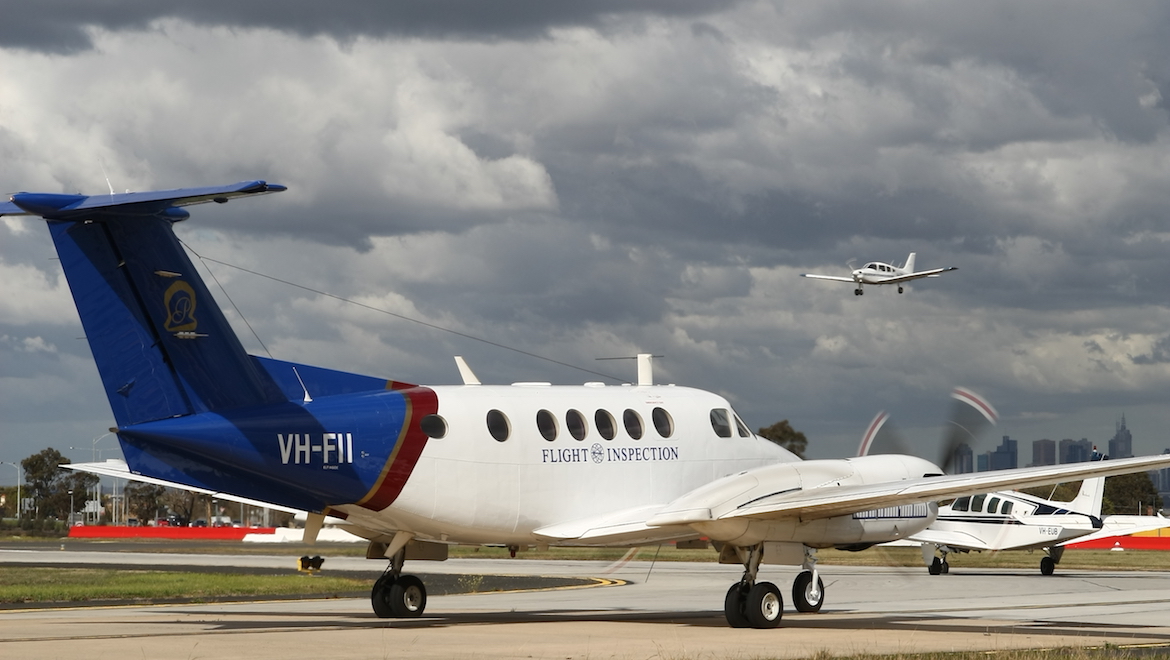
This story first appeared in the December 2009 edition of Australian Aviation.














Colin Campbell
says:VH-FII is now resident at the Queensland Air Museum, Caloundra. Thanks to Pearl Aviation for donation of this aircraft.